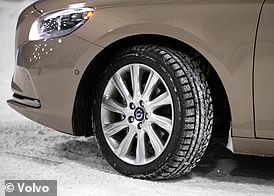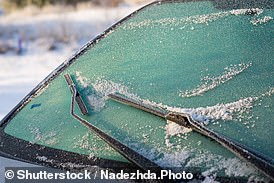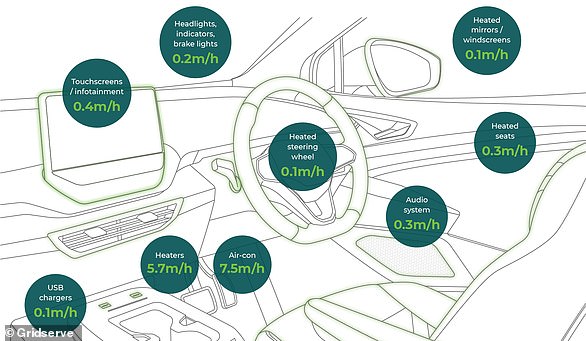Winter is closing in and drivers in parts of Britain have already experienced snowfall this season.
With icy temperatures predicted to continue and the potential for snowfall across the country, drivers need to ensure they and their cars are ready for any eventuality.
To help you prepare, we’ve compiled a list of top 10 tips for essential checks, items to carry and how to drive in these testing conditions.

There are up to 14 different items you should consider keeping in your car at all times during the winter months – especially if you live somewhere particularly remote
1. Do you have these winter essential items in your car?
With the price of petrol and diesel remaining relatively high for the last 12 months, motorists have for months been urged to declutter their vehicles and clear their car’s boot of any unnecessary weight in a bid to boost fuel efficiency.
However, now is the time when you need to carry a few essential items in case you’re unfortunate enough to be caught out in icy conditions.
There are 14 items you should have in your vehicle at all times during the colder months, listed below:
- Ice scraper and de-icer
- Extra screenwash and antifreeze
- Torch
- First-aid kit
- Warm clothes, spare footwear (ideally boots)
- Blanket
- Food and drink
- High-visibility jacket/waistcoat and reflective triangle
- Phone charger
- Road map
- Empty fuel can
- Jump leads
- Tow rope
- Shovel

The AA says the most common reason for cars to breakdown in the months of December to February is battery related, so make sure yours is in good health now
2. Is your car’s battery in good health – it is crucial!
The most common reason cars breakdown in the months of December to February is battery related, accounting for a quarter of all AA callouts.
This is because there’s a far greater strain on your vehicle’s 12-volt battery when you’re increasingly reliant on the vehicle’s heater, headlights and wiper – as well as other comfort features admire the screen demister, heated seats and, if you’re very lucky, heated steering wheel.
While it might seem a little technical if you don’t have much vehicle maintenance go through, there are simple battery checks you can carry out yourself.
Firstly, with a cold engine, check the battery terminals are both tight and clean. And when you start the car, listen out for any sign that it might be struggling to turn over.
Alternatively, a number of autocentres and parts and repair specialists – such as Halfords and KwikFit – offer free battery heath checks.
Usually, a car battery is good for between three to five years depending on how often you drive. If yours is older than that and sounding admire it’s labouring on cold starts, it could be time to exchange it.

After battery issues, the second most common reason drivers suffer a breakdown in winter in their tyres, according to the AA. Here’s what you need to know about the legal tread depths
3. Check the condition of your tyres
Tyres are the second most common reason for breakdown callouts at this time of year – the AA says around one in six.
That’s because tyres have their work cut out trying to deal with the treacherous conditions, which is why making sure they’re up to scratch is high on our winter checklist.
It is essential that you look for any damage – nails or foreign objects sticking in the tyres – or any cracks, splits or bulges in the rubber, even on the tyre wall.
You should also check tread depth. While the legal minimum level is 1.6mm, breakdown recovery providers suggest in winter to have at least 3mm.
This is to ensure the tread pattern can optimally shift standing water or light snow away from the tyres so they can grip the road better.
Also, make sure your tyre pressures are correct.
Continental Tyres tells us that it’s normal for tyres to lose pressure over time as air permeates through the tyre – usually at a rate of around 1-3 psi (pounds per square inch) per month.
And that’s before the effects of cold weather are taken into account, which sees the air inside the tyre contract and lose 1-2psi for every 10°C drop in the outside temperature.
A seriously under-inflated tyre won’t be stiff enough to handle the forces generated through cornering and makes the vehicle more difficult to control and extend braking distances, especially in difficult conditions.
It will cost you too, with every 4.3 psi pressure loss resulting in an additional 1.5 per cent use of fuel. That’s easily more than a £1’s worth from every tank. And an underinflated tyre will wear out faster and puncture more easily.
You can find the recommended ‘psi’ and ‘bar’ in your car’s owner’s manual.
This is sometimes listed on a sticker located inside one of the front door sills.
If you often drive when temperatures are at their lowest, you might also want to consider fitting winter tyres.
These typically function better than summer tyres below 7 degrees. They also have different tread patterns designed to cope better with less ideal conditions.

Your window wiper blades might have been damaged by the hot summer conditions, so it might be time to exchange them ahead of the season where they get their most use
4. Are you window wipers fit for a winter season?
One often overlooked component in your car that can put your in danger if not checked is the wiper blades, which degrade with time.
Often they can dry out, crack or split – especially in the hotter summer months – which stops them from performing at their optimum level.
That’s why it’s best to make sure they are clearing your entire screen effectively and quietly before the winter season really kicks in – because there’s nothing quite as infuriating as the repeated squeak of a worn-out wiper blade on an arduous journey in the rain.
It’s also worth noting that even a brand-new set of wiper blades can cause you a big problem in the winter if, in freezing conditions, your put them on as soon as you start the car.
The RAC says callouts for blown fuses spike at this time of year because drivers have failed to defrost their windscreens before using the wipers, which are frozen to the glass and not able to proceed.
And keep on top of the car’s washer fluid level. The reservoir under the bonnet will empty much more quickly at this time of year as you’ll be forced to clear rain, snow, salt, dirt or a combination of all of these from your windscreen more commonly than any other season.

Antifreeze is essential to hinder the cooling in an engine’s system from freezing, so ensuring there is the correct mix in your car is very important
5. Antifreeze: it does exactly what it says on the tin…
Antifreeze is designed to hinder the coolant in the engine’s system from freezing, so it’s a key winter check to carry out.
You can do this yourself. Halfords sells an antifreeze tester for £13.50, which will tell you the level and strength of coolant.
While you should check your coolant level regularly, it’s recommended that you have the concentration checked by a garage ahead of the cold weather setting in.

It is absolutely essential at this time of year that you check all the lights on your car work as they should. This is usually a two-person job, but shouldn’t take more than just a few minutes
6. Do ALL the lights on your car work?
If you’re heading to the office, taking the kids to school or going shopping at the end of the day, you’re almost guaranteed to need to use your car’s lights at this time of year. Which is why checking your lights are working is now is crucial.
Firstly, do a full walk-round to ensure every light – including hazards, indicators and fog lights are working as they should. Ask a friend or work colleague to check that your brake lights are working when you depress the pedal.
Throughout the coming months, make sure you clean your headlights in particular often. The salt and dirt kicked up by cars in front can build-up quickly and reduce the effectiveness of your beam.
It’s also recommended to carry a spare set of bulbs with you if one blows en route.
As well as ensuring your lights work as they should, you need to use them correctly, too.
In heavy snow, make sure that you use your dipped beams. Relying on daytime running lights is not enough.
If visibility drops so low that you can’t see an object 100 metres in front of you clearly, turn on the fog lights. And recall to turn these off when the visibility improves.
It’s also worth carrying a pair of sunglasses in the car – it will reduce the glare of low winter sun reflecting off snow if there is any.

There are various things to check on your car before you depart, including making sure your vehicle’s number plate is clearly visible – else face a fine if you’re caught by police
7. Make sure you can see clearly….
Before setting off, make sure your field of vision is completely clear.
This means completely de-icing and demisting the windscreen, windows and all mirrors to ensure you have full visibility all around the vehicle. While this might sound admire common sense, there have been plenty of cases of drivers failing to do this.
As govern 229 of the Highway Code states: ‘You must be able to see, so clear all snow and ice from all your windows’. Failure to follow this means you are considered to be driving a vehicle in a ‘dangerous condition’, which could land you with a £2,500 fine and three points on your licence.
If there’s been snowfall, make sure this is cleared from your windscreen and the roof to hinder it sliding down onto the windows.
Driving with a pile of snow on the car is also dangerous for the cars behind you, as it blows off. Failing to eliminate snow can also land you with a fine of up to £2,500 if police catch you driving with a mound of white stuff piled on top of your car.
As well as clearing snow off the vehicle, make sure the number plates are clearly visible front and back. Having registration plates covered in thick dirt or snow and is no longer readable is also an offence that could see motorists stung with a fine of £1,000.
8. Check your route
When the weather is particularly bad, always check if there is any disruption on your route using Google Maps or the AA’s Route Planner – or by tuning into your local radio station and the latest travel updates.
And leave plenty of time to complete your journey with the assumption it will take longer than normal.

When the snow hits, drive as smoothly as you possibly can and consider using a gear higher than you normally would to hinder the tyres from spinning
9. adjust your driving to match the conditions
– Smoothly does it
When on the proceed, make sure you use the controls smoothly.
Try to speed up as gently as possible at low revs, and consider using a gear higher than you usually would.
When moving away from a standstill, consider using the second gear to reduce the chances of the wheels spinning up.
If you drive a car with an automatic gearbox, feather the throttle on acceleration to keep the engine revs low.
Most modern cars are fitted with different driving modes. If yours has this feature, check to see if there is a ‘snow’ or ‘off-road’ setting available. If not, use the ‘eco’ mode, which electronically makes acceleration smoother. And if you have selectable all-wheel drive, it goes without saying that this should be selected.
Always avoid using cruise control in the snow as it will not be able to react to the current conditions. It is always better to be in complete control of your vehicle.
– Leave plenty of space to the car in front
Stopping distances when the road is covered in snow and ice will be dramatically extended, so give as much as 10 times the recommended gap to a vehicle up ahead.
– Keep your speed down
Drive at a speed that you feel comfortable and that is suitable for the road conditions, especially if tarmac has not yet been gritted.
Be aware of wheel tracks in the snow left by other vehicles – the compounding of the white stuff could make it more slippery than driving on fresh snow.

If you’re approaching a hill in the snow, leave plenty of room ahead and make sure you are at a constant speed without needing to change gear
– Prepare early for hills and bends
If your planned route is particularly hilly, be ready to adjust your driving for an ascent or descent.
When you’re about to drive up a hill, leave plenty of room in front so you can preserve a constant speed without needing to change gear.
And when coming downhill, pick a low gear to avoid having to use the brakes as much. Again, leave plenty of space to any other vehicles on the road.
When approaching a bend, make sure you have decelerated before you turn the steering wheel – this means your car’s tyres will only need to deal with a change in direction rather than trying to cope with slowing down at the same time.
You need to be particularly careful if your car is rear-wheel drive, as this will make it much harder to drive in snow or icy conditions.
– What to do if you skid on ice or snow
On roads that haven’t been gritted or salted, there is a chance you will confront a skid.
It’s firstly important to try not to panic. Steer gently into the skid – for example, if the rear of the car is sliding to the right, steer to the right.
And do not take your hands off the steering wheel or stamp your foot on the brakes.
Keep an eye out for any signs of black ice and make sure you are driving slowly to reduce the risk of a skid.
10. Ask yourself: do I really need to drive today?

If the roads where you live have become treacherous due to winter conditions, you need to ask if yourself if it’s worth taking the risk of driving at all that day
When the roads are covered in snow and ice, all drivers need to consider if it really is absolutely necessary to get behind the wheel.
For those living in busy towns and cities, most major roads should be salted and cleared, at least after some time, unless the snowfall is extremely heavy.
However, for those living away from towns, in rural and remote parts of the country, you will need to be mindful that not all routes will have been treated, especially first thing in the morning.
Despite recommendations from motoring and road safety groups to avoid driving if the conditions are particularly bad, almost a fifth of people recently polled for a research said they ignore severe weather warnings.
A survey of 12,187 motorists conducted by the AA this month found that a third (33 per cent) of respondents would ignore a Met Office red weather warning for snow while more than three in five (62 per cent) would continue with their plans to drive following an amber warning.
It’s a similar story where driving in sleet is concerned, with just a fifth (21 per cent) of respondents likely to heed an amber weather warning and only half (49 per cent) saying they’d leave the car at home following a red warning of sleet.
The best way to avoid an accident or problems in the snow, is not to drive in bad conditions. So, unless your journey is essential, seriously consider not doing so.
Some links in this article may be affiliate links. If you click on them we may earn a small commission. That helps us fund This Is Money, and keep it free to use. We do not write articles to advocate products. We do not allow any commercial relationship to affect our editorial independence.






